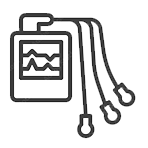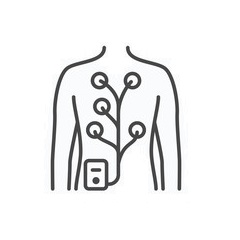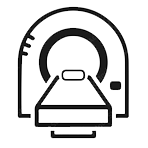Vascular Ultrasound
Q & A
Test Overview
A Doppler ultrasound test looks at how blood moves through a blood vessel by using sound waves that have been reflected. It helps doctors figure out how much blood is flowing through the arms, legs, neck, and other major arteries and veins. It can show where blood flow is blocked or slowed down in the main arteries of the neck. This could cause someone to have a stroke. The test can also find deep vein thrombosis (DVT), which is a blood clot in a leg vein that could break loose and block blood flow to the lungs. A pulmonary embolism is the name for this kind of problem. Doppler ultrasound can be used to check the health of an unborn baby by looking at the blood flow in the baby.
During a Doppler ultrasound, a hand-held device is moved lightly over the skin above a blood vessel. The name for this thing is a transducer. A microphone amplifies the sound waves that it sends and receives. Sound waves bounce off of solid things, like blood cells. The pitch of the sound waves that are reflected changes when blood cells move. The Doppler effect is the name for this. If the blood doesn’t move, the pitch doesn’t change.
Graphs or pictures can be made from the reflected sound waves to show how blood moves through the blood vessels. These graphs or pictures can be saved and reviewed later.
There are three main types of Doppler ultrasound.
“Bedside” or Doppler with a continuous wave.
This type shows how blood is moving through a blood vessel by how the pitch of the sound waves changes. The doctor listens to the sounds made by the transducer to figure out how much blood is flowing through an area that may be blocked or narrowed. This kind of ultrasound can be done at a hospital patient’s bedside. It uses a portable machine that can quickly find out how bad damage or disease is to blood vessels.
Duplex Doppler.
This test takes a picture of a blood vessel and the organs around it using standard ultrasound techniques. The Doppler sounds are turned into a graph by a computer. This graph shows how fast and which way the blood moves through the blood vessel.
Color Doppler.
Color Doppler takes a picture of a blood vessel using standard ultrasound techniques. The Doppler sounds are turned into colours by a computer, which are then added to the picture of the blood vessel. These colours show how fast blood is moving through the vessel and in what direction. Power Doppler is a type of colour Doppler that is unique. Power Doppler can get some images that standard colour Doppler can’t or can’t get at all. Most of the time, power Doppler is used to look at how blood moves through the vessels of solid organs.
Why It Is Done
Doppler ultrasound is used to:
Almost any part of the body can have blood clots and blocked or narrowed blood vessels. Most of the time, it’s put on the neck, arms, and legs.
Check for intermittent claudication if you have leg pain. This is a condition caused by atherosclerosis of the lower limbs.
After a stroke or other condition that could be caused by a problem with blood flow, check the blood flow. A test called transcranial Doppler (TCD) ultrasound can do this after a stroke.
Check for spider veins or other problems with your veins.
Map veins that could be used for grafts between blood vessels. It can also check the health of grafts used to keep blood from getting stuck in an arm or leg.
Find out how much blood is going to a kidney or liver that has been transplanted.
Watch the blood flow after surgery on a blood vessel.
Find out if arterial plaque is there, how much of it there is, and where it is. If there is plaque in the carotid arteries, less blood can get to the brain. This could make you more likely to have a stroke.
Help treat abnormal veins with laser or radiofrequency ablation.
Check the baby’s health. It might stop blood from flowing through the umbilical cord, the placenta, or the fetus’s heart and brain. This test can tell if the baby in the womb is getting enough oxygen and food. Doppler ultrasound may be used to guide decisions during pregnancy when:
The baby is smaller than usual for how far along it is. The umbilical artery, a large blood vessel in the umbilical cord, can be looked at to see how blood moves through it.
There has been Rh sensitization. The health of the foetus can be checked by measuring how much blood flows through a blood vessel in the brain.
There are other problems with the mother, like preeclampsia or sickle cell disease.
Children with sickle cell disease may need a transcranial Doppler (TCD) ultrasound. The test can find out if there is a chance of a stroke.
How to Do It
This test is done in a hospital or doctor’s office that has an ultrasound room.
You will need to take off any jewellery that could affect the Doppler ultrasound scan. You might be asked to drink water right before the test so that your bladder is full. Depending on what part of your body is being checked, you may need to take off all or most of your clothes. You might be able to keep your underwear on if it doesn’t make a difference in the test. During the test, you will be given a cloth or piece of paper to cover yourself.
You will lie on your back for an abdominal scan.
For chest scans, you will lie on your back with your neck slightly stretched out.
Your head may be turned to one side for head and neck scans.
For a scan of your arm or leg, your head will be raised just a bit. The arm or leg that is showing will be turned a little bit outward. You may be asked to lie on your stomach for a leg scan.
During pregnancy, you will lie on your back or your left side with your belly out.
Gel is put on the skin to make it easier for the sound waves to get through. After putting the transducer in the gel, it is moved along the skin. During the test, you need to lie very still. The flow of blood through the blood vessels can make sounds.
Arteries in the arms and legs
People often do this test on both arms or legs. Even if the problem with blood flow is only thought to be in one limb, both can be tested to see how they differ. If your arms are being checked, they will be checked first while you are lying down. Then they’ll be tested again while you wait.
A blood pressure cuff may be wrapped around one or both limbs, depending on which blood vessels are being checked. It makes it possible to take your blood pressure in different places. A blood pressure cuff may be wrapped around the calf and then the thigh when the legs are being checked. The test can be done in a few different spots on your leg. When the arms are being tested, the pressure cuff may be wrapped first around the forearm and then around the upper arm.
If you are healthy enough, tests can be done before and after you work out.
Veins in the arms and legs
You will be asked to lie down and breathe normally for this test. You must lie very still. Changes in blood flow caused by how you breathe are recorded.
The test can be done again while the examiner presses on your veins close to the skin’s surface. This helps find where a blood clot is in the vein. The name for this is a compression manoeuvre. The examiner may do this move with your legs or arms in different positions. This is to make sure that these positions don’t cut off the flow of blood. He or she may also squeeze your calf or forearm to help the blood move through your veins more quickly. It’s called a “enhancement manoeuvre.” It checks how much blood is going to your heart.
While your legs are being checked, you may also be asked to try to breathe out strongly with your mouth closed and your nose pinched. The name for this is the Valsalva manoeuvre. It usually makes the blood flow through the veins change quickly.
Arteries in the neck
You will be asked to lie down and put a pillow under your head for support. On both sides of your neck, the test is done. Then, the results are compared to standard values to see how blocked or narrowed the arteries are.
Transcranial ultrasound
For this type of ultrasound, the transducer is lightly moved over the skin at the base of your skull or along the side of your head.
How long the test is
It will take 30 to 60 minutes to do the test.










